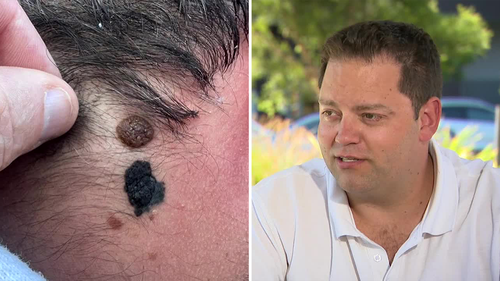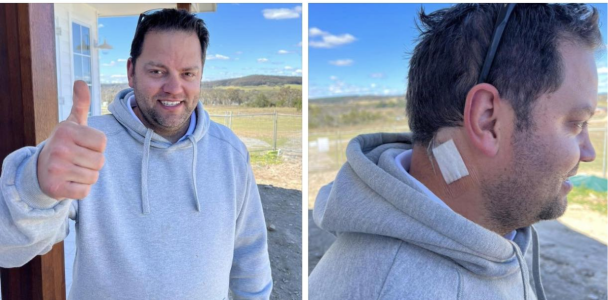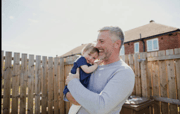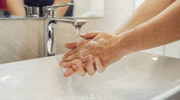You won't believe how this homeowner saved a handyman's life with just one sentence
- Replies 7
Jack Channells, a 32-year-old painter, recently visited the home of Jay Allen, a gracious man whom Jack had little knowledge about. Little did Jack know, but Jay is a skin cancer prevention advocate and melanoma survivor.
Despite both men not being aware of their shared connection at the time of the visit, Jack quickly learned of it when Jay asked him what he had on the back of his neck. Jack's response of 'Is that paint at the back of your neck?' actually saved his life. It turns out that Jack had gone to a GP four years earlier, had a shave biopsy, and was told the mole was benign.
But Jay, whose line of work meant he was experienced when it came to moles, was sure there were issues with the mole, and encouraged Jack to get it cut out. He took a photo of the mole, sent it to an expert he knew, and contacted several clinics in the vicinity to get Jack an urgent appointment.
When the mole was removed, more testing was done and it was diagnosed as a melanoma. Jack was later admitted to hospital and had further testing done, including a PET scan, and several lymph nodes needed to be removed. The case raises questions about how a mole that was initially deemed benign could turn deadly within four years, as well as GP training and its adequacy when it comes to skin cancer.
Asked by a media source how people should respond if they think something might be amiss, the President of the Royal Australian College of General Practitioners, Dr Nicole Higgins, said: 'Your GP is your first port of call. If you're concerned, get a second opinion. Melanomas can change very quickly, so if anyone notices a change in a skin lesion, it must get checked out.'
Jack and Jay are in agreement that this story holds a very valuable lesson: if you think something’s wrong, always remember to trust your instincts and get a second opinion!
We wish Jack all the best and hope his story encourages others to take action and warn against the dangers of skin cancer.

Unfortunately, skin cancer is a widespread and deadly problem in Australia. According to the Cancer Council Australia, more than 2,000 Australians lose their battles to skin cancer annually, with an estimated 15,000 new cases of melanoma being clinically diagnosed every year. Given the nation's high levels of ultraviolet (UV) radiation, Australians are at a significantly higher risk of skin cancer than those who reside in other parts of the world. The country has one of the highest rates worldwide, with Cancer Council stating that Australia and New Zealand bear the largest burden collectively, accounting for over 30 percent of global cases.
Prevention and early detection are vital in the fight against skin cancer. The Cancer Council advocates for regular skin checks, advising that getting into the habit could, quite literally, save your life. Skin cancer is one of the few cancers that is visible to the naked eye, and early detection can increase survival rates significantly.
The story of Jay and Jack stands as a strong reminder of the importance of awareness and timely intervention. It serves as a wake-up call for all Australians to be vigilant about their skin health and to never ignore any unusual changes. While the statistics might be daunting, being informed and proactive about skin health could make all the difference. As the old adage goes, 'prevention is better than cure.'
For our members, always remember to get your skin checked from time to time, to protect your skin from sun damage whenever you can, and remember to use SPF 50+ sunscreen, wear plenty of protective clothing, always wear a UV-blocking hat so you can enjoy all your outdoor activities! Be safe as always, lovely members! What do you think about this story members? Have you ever found a skin cancer on your own or someone else’s skin? Let us know in the comments below!
Despite both men not being aware of their shared connection at the time of the visit, Jack quickly learned of it when Jay asked him what he had on the back of his neck. Jack's response of 'Is that paint at the back of your neck?' actually saved his life. It turns out that Jack had gone to a GP four years earlier, had a shave biopsy, and was told the mole was benign.
But Jay, whose line of work meant he was experienced when it came to moles, was sure there were issues with the mole, and encouraged Jack to get it cut out. He took a photo of the mole, sent it to an expert he knew, and contacted several clinics in the vicinity to get Jack an urgent appointment.
When the mole was removed, more testing was done and it was diagnosed as a melanoma. Jack was later admitted to hospital and had further testing done, including a PET scan, and several lymph nodes needed to be removed. The case raises questions about how a mole that was initially deemed benign could turn deadly within four years, as well as GP training and its adequacy when it comes to skin cancer.
Asked by a media source how people should respond if they think something might be amiss, the President of the Royal Australian College of General Practitioners, Dr Nicole Higgins, said: 'Your GP is your first port of call. If you're concerned, get a second opinion. Melanomas can change very quickly, so if anyone notices a change in a skin lesion, it must get checked out.'
Jack and Jay are in agreement that this story holds a very valuable lesson: if you think something’s wrong, always remember to trust your instincts and get a second opinion!
We wish Jack all the best and hope his story encourages others to take action and warn against the dangers of skin cancer.
Key Takeaways
- Painter Jack Channells visited the home of melanoma survivor Jay Allen for a painting quote, where the latter noticed a suspicious mole on Jack’s neck.
- Despite previously being checked and deemed benign, Allen urged Channells to get it re-examined, leading to a diagnosis of melanoma.
- The case raises questions about the adequacy of GP training and the potential for a benign mole to turn deadly within a few years.
- Both men encourage individuals to get second opinions if they’re not happy with initial medical assessments and to not underestimate the risk of skin cancers.
Unfortunately, skin cancer is a widespread and deadly problem in Australia. According to the Cancer Council Australia, more than 2,000 Australians lose their battles to skin cancer annually, with an estimated 15,000 new cases of melanoma being clinically diagnosed every year. Given the nation's high levels of ultraviolet (UV) radiation, Australians are at a significantly higher risk of skin cancer than those who reside in other parts of the world. The country has one of the highest rates worldwide, with Cancer Council stating that Australia and New Zealand bear the largest burden collectively, accounting for over 30 percent of global cases.
Prevention and early detection are vital in the fight against skin cancer. The Cancer Council advocates for regular skin checks, advising that getting into the habit could, quite literally, save your life. Skin cancer is one of the few cancers that is visible to the naked eye, and early detection can increase survival rates significantly.
The story of Jay and Jack stands as a strong reminder of the importance of awareness and timely intervention. It serves as a wake-up call for all Australians to be vigilant about their skin health and to never ignore any unusual changes. While the statistics might be daunting, being informed and proactive about skin health could make all the difference. As the old adage goes, 'prevention is better than cure.'
For our members, always remember to get your skin checked from time to time, to protect your skin from sun damage whenever you can, and remember to use SPF 50+ sunscreen, wear plenty of protective clothing, always wear a UV-blocking hat so you can enjoy all your outdoor activities! Be safe as always, lovely members! What do you think about this story members? Have you ever found a skin cancer on your own or someone else’s skin? Let us know in the comments below!
Last edited by a moderator:









